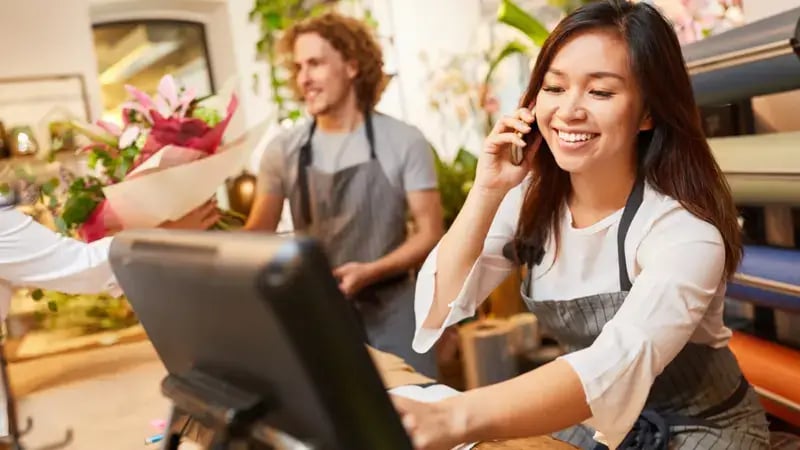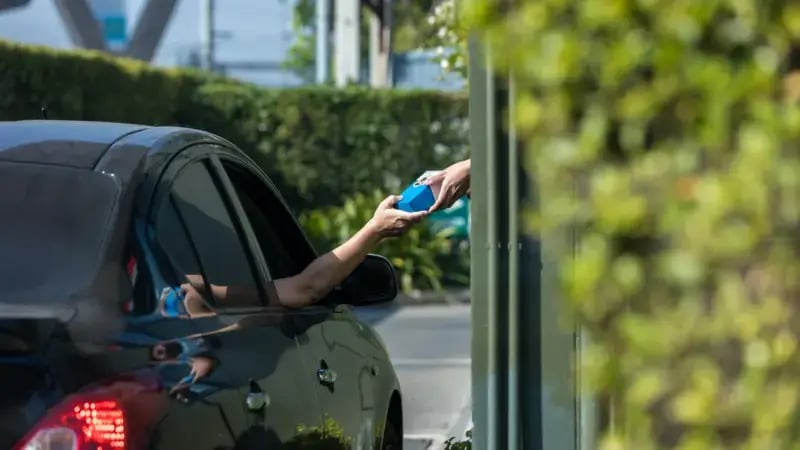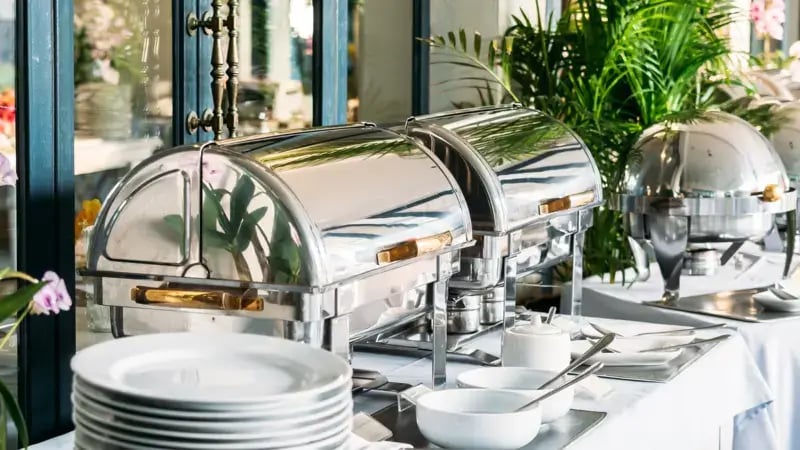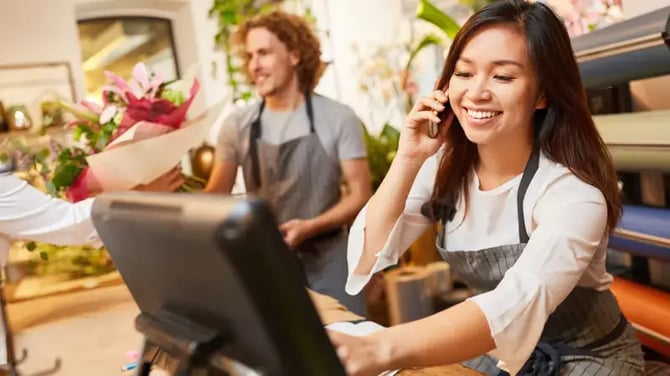Restaurant call centers are becoming increasingly popular, and for good reason.
They can help restaurants manage their hostess time more effectively, allowing internal staff to focus on the guest experience.
External call center representatives can help:
- Take reservations
- Online orders
- Drive-thru orders
- Catering requests
- Special occasion reservations
This can be a significant cost-effective solution for restaurants, especially those that are struggling to keep up with the increasing demand for take-out and delivery orders.
In this blog post, we will discuss the multiple ways that restaurant call centers can help improve restaurant efficiency.
Top 4 ways to utilize call centers for your restaurant
1. Taking phone calls for food orders
Ever since restaurants have been heavily promoting online ordering over the past several years, the market for takeaway and delivery has increased by around 13%.
But, nearly 90% of guests still like placing a phone order for delivery or takeaway.
The main reason for encouraging restaurant guests to purchase online is to save money by having fewer personnel work on-site.
Ordering online, however, has the cons of not always enhancing the consumer or guest experience.
For example, most individuals aren't confident enough in technology to use it to place their own takeaway orders.
The majority of guests need the assurance that comes with chatting with a real person in order to confirm that their order is accurate and that the restaurant is open and equipped to handle it.
Despite how wonderful today's technology is, a lot may go wrong with an order as it travels from the customer's phone through the restaurant's servers to the customer's desired location.
That's where restaurant call centers come in. For some, an empathic live voice answering the phone and taking their order is the most comforting feeling there is.

2. For drive-thru ordering
Drive-thru ordering is a convenient and popular way for customers to order food from restaurants.
However, it can also be time-consuming and costly for restaurants.
Call centers can help to streamline drive-thru ordering by:
- Taking orders over the phone: Call center agents can take orders over the phone and then relay them to the restaurant staff. This can free up in-house staff to focus on other tasks, such as preparing food and serving customers.
- Using voice recognition technology: Call centers can use voice recognition technology to take orders over the phone. This can further reduce the time it takes to take orders and can also improve the accuracy of orders.
- Using mobile ordering apps: Call centers can integrate with mobile ordering apps to allow customers to place orders in advance. This can further reduce the time it takes to take orders and can also improve the customer experience.

Call centers can also help to reduce the cost per order for drive-thru orders.
This is because restaurant call center agents can be paid less than in-house staff and because call centers can use technology to streamline the order-taking process.
3. Taking restaurant reservations
Call centers can improve the customer experience for restaurant reservations in a number of ways, including:
- Providing personalized service by helping customers choose the perfect table for their party, make special requests, and answer any questions they may have about the restaurant or the menu.
- Making it convenient for customers to make reservations by being available 24/7 and by offering a variety of ways to make reservations (such as over the phone, online, or through a mobile app).
- Ensuring the accuracy of reservations by taking down all of the necessary information and repeating it back to the customer for confirmation.
- Being flexible in accommodating customer requests, such as rescheduling reservations or finding a table for a larger party than originally planned.

4. Restaurant catering
Call centers can play an important role in helping restaurants to handle catering orders and improve the customer experience.
Here are some of the ways that call centers can help with catering orders:
- Taking orders: Call center agents can take catering orders over the phone, online, or through a mobile app. This can free up in-house staff to focus on other tasks, such as preparing food and serving customers.
- Answering questions: Call center agents can answer customer questions about the catering menu, pricing, delivery, and setup. This can help customers to make informed decisions about their catering orders.
- Providing personalized service: Call center agents can work with customers to create a custom catering menu that meets their specific needs and budget. They can also help customers to coordinate delivery and setup, and to make any special requests.
- Resolving issues: If any problems arise with the catering order, call center agents can work with the customer to resolve them quickly and efficiently.

Restaurant call center alternatives:
In addition to a restaurant call center, there are a number of other solutions that you can make use of to improve your guest experience and staff efficiency, such as phone integration software.
Phone integration software allows you to connect your phone system with your other systems, such as your POS system, reservation system, and CRM system. This can help you to streamline your operations and provide a better guest experience.
Here are a few examples of reservation systems and software that offer phone integration:
10 Best phone integrations and systems
Reservation administration, order processing, call routing, reporting, and integration capabilities are just a few of the features and functions that phone systems provide that are specifically suited to the requirements of restaurants.
To choose the system that best suits your unique requirements, it's advised that you explore each one, evaluate your restaurant's demands, and compare the features, costs, and customer evaluations.
1. OpenPhone
A dedicated business phone number that is distinct from personal phone lines is one of the many advantages that OpenPhone can provide restaurants.
This keeps things professional and makes sure that business calls are distinct from personal calls.
Additionally, OpenPhone provides online and mobile applications that let restaurant personnel use their cell phones, tablets, or laptops to place and receive professional calls.
Text messaging, which is growing more and more crucial for companies, especially restaurants, is supported by OpenPhone.
Text messaging offers a quick and effective channel of communication for restaurants to reach out to consumers for order confirmations, reservation reminders, and other crucial information.
Restaurants may customize after-hours settings and define their own business hours using the system.
This guarantees that each missed call received after business hours is handled properly, such as by leaving a message on voicemail or forwarding it to a different contact.
2. Eat App
Eat App's phone integration feature offers a seamless and efficient solution for restaurants looking to enhance their guest management capabilities.
One of its standout features is the ability to see who's calling before you even answer the phone.
This empowers restaurant staff to personalize their interactions with guests, making them feel valued and recognized from the moment they reach out.
>>> You can try it out for free here.
Additionally, the integration allows for quick and hassle-free affiliate guests to reservations with just one click, streamlining the reservation process and ensuring that no important details are overlooked.
Moreover, missed calls are automatically logged within the system, enabling staff to promptly call back guests who may have inquired about reservations or other restaurant-related matters.
With the option to go straight to the guest's profile, restaurant employees can access vital information about preferences, allergies, or special requests, allowing for a more personalized and memorable dining experience.
Furthermore, the phone integration feature supports the management of calls from multiple venues on one screen, making it a valuable tool for restaurant chains and multi-location establishments.
This centralized approach enhances efficiency and coordination, ensuring that guests receive consistent and exceptional service across all locations.
Eat App's phone integration feature truly revolutionizes the way restaurants handle their customer interaction and communications, offering a comprehensive and user-friendly solution that improves both guest satisfaction and operational efficiency.
3. Talkroute
A virtual phone system called Talkroute offers capabilities like call forwarding, voicemail transcription, and auto-attendant that are appropriate for restaurants.
It provides virtual phone numbers and has an intuitive online interface for management.
Additionally, the technology enables restaurants to set up call routing and forwarding rules depending on particular factors like the time of day or the location of the caller.
Calls can be routed to various departments or employees, guaranteeing that clients promptly speak with the appropriate party.
The system also has an automated attendant that welcomes callers with personalized greetings and alternatives.
Restaurants may set up interactive menus, phone queuing, call recording, voicemail, and professional welcomes.
4. Nextiva
The greatest phone system for businesses, including restaurants, is Nextiva, which provides a range of features and services.
With the use of Nextiva's virtual phone numbers, which can be local or toll-free, restaurants can have separate phone lines for various reasons at one or more locations.
They can, for example, have different phone lines for bookings, takeaway orders, and customer service, simplifying communication and improving the client experience.
When a customer calls a restaurant, they are welcomed with a professional message and can be directed to the relevant alternatives, such as making a reservation or placing an order, thanks to Nextiva's auto attendant feature.
Additionally, the system offers comprehensive analytics and reporting tools that let restaurants monitor call-related parameters including call volume, wait times, and call durations.
The performance of customer service can be examined using this data, and adjustments can be made based on the results.
5. 3CX
Restaurants can make use of a number of features and services provided by 3CX, a software-based IP PBX system.
Key service unit (KSU system) call management capabilities from 3CX include call forwarding, call routing, and call queuing.
Restaurants can manage calls effectively, route calls to various departments or extensions, and make sure that every call is immediately answered and that the number of missed calls is greatly decreased.
Callers are greeted by personalized messages through an automated virtual receptionist (IVR) function in 3CX as they are led through menu selections.
Franchises with one location or several locations can utilize this functionality to communicate details like opening times, menu selections, reservation procedures, or delivery and takeaway services without tying up company lines.
Additionally, the system is compatible with a number of CRM (Customer Relationship Management) programs widely used in the restaurant business.
Restaurants can utilize this interface to automatically record client interactions, retrieve caller information, and offer individualized service based on past patron behavior.
6. Ring Central
Restaurant personnel can place and receive business calls from their smartphones, tablets, or laptops thanks to RingCentral, a cloud-based communication and collaboration platform that provides a wide range of features and services.
Advanced call routing features from RingCentral include call queuing, IVR (Interactive Voice Response), and auto-attendant.
By properly directing calls to the appropriate extensions, departments, or staff members, restaurants can better assist their customers and cut down on wait times.
Restaurant personnel can connect internally, exchange information, and work together in real time thanks to RingCentral's team messaging and collaboration solutions.
Operations are streamlined, jobs are coordinated, and overall efficiency is improved.
7. CallHippo
With the use of devices with an internet connection, companies can place and receive calls from anywhere utilizing the virtual phone company and communication platform CallHippo.
The finest restaurant phone system is one that provides a variety of features and functions that are intended to speed up communication and improve customer service.
Restaurants can redirect calls to various devices or departments by using CallHippo's virtual phone numbers (VoIP phone numbers) from different nations.
For example, calls can be routed to various employees or departments depending on the nature of the enquiry, ensuring that clients promptly speak with the appropriate individual.
8. Ooma Office
A cloud-based phone system designed for restaurants is offered by Ooma Office. It includes features like call forwarding, virtual extensions for various departments, and call management capabilities.
It also offers mobile and online tools that let restaurant personnel manage calls, check voicemail, and make and receive business calls from their cell phones, tablets, or laptops.
This helps popular POS systems expedite operations.
When staff employees are not accessible, callers can leave messages on the system's voicemail services.
To ensure that essential messages are received and addressed right away, voicemail messages can be retrieved through the phone system or forwarded to email.
9. MyOperator
A cloud-based phone system for restaurants is provided by MyOperator. IVR, call tracking, call recording, and call analytics are some of its functions.
The technology aids restaurants in managing incoming calls, monitoring marketing initiatives, and enhancing patron service.
An IVR system offered by MyOperator welcomes customers with personalized greetings and alternatives.
Restaurants can set up automated menus to direct calls, display menu selections, accept bookings, and provide information about opening hours.
On call volumes, durations, peak hours, and other call-related parameters, the system also offers in-depth analytics and reports.
Restaurants can increase operational efficiency by learning about customer call trends, keeping an eye on employee performance, and making data-driven choices.
10. 7shifts
7shifts provides a phone system for restaurants and other small enterprises in the food industry, while it's mostly recognized as a restaurant scheduling and labor management platform.
Restaurants can quickly manage calls and interact with their personnel thanks to its caller ID, voicemail, and call routing capabilities.
Additionally, the system offers capabilities for establishing and maintaining personnel schedules.
It's simple for restaurants to create timetables, allocate shifts, and deal with requests for time off or shift adjustments.
The platform enables restaurants to make data-driven decisions to optimize labor expenditure and increase profitability.
It also assists restaurants in monitoring and controlling labor costs by offering insights into labor expenses, predicted labor costs, and actual labor costs.
How to select the best phone system for your restaurant?
In order to select the best phone system, you must carefully analyze your unique demands and weigh several criteria.
A step-by-step approach to selecting the ideal restaurant phone system is provided below:
- Analyze your needs: To set up communication for a restaurant, consider the volume of calls, number of extensions, reservation management, online ordering integration, and necessary features for operations.
- Make a list of the key qualities you need: This can include call forwarding, call routing, call recording, voicemail, automated attendants, integration with platforms for reservations or ordering, and any other features particular to the requirements of your restaurant.
- Think about scalability: When choosing a phone system for your restaurant, consider scalability to accommodate future growth without requiring significant adjustments or expenses.
- When budgeting for a phone system, consider installation, subscription, and additional costs. Evaluate potential benefits, such as improved customer service, operational effectiveness, and cost savings, against the return on investment.
- Review reading and getting recommendations: To evaluate phone systems, seek input from reliable sources, trade forums, and companies similar to yours.
Takeaways
Restaurants can benefit from call centers to improve efficiency and customer service.
By outsourcing phone operations, staff can focus on other tasks. Call centers can provide 24/7 customer support, take orders and reservations, and answer questions.
Phone integration software can also streamline operations by connecting systems like POS, reservations, and CRM. The best solution depends on a restaurant's specific needs.
FAQ
Frequently Ask Questions
In essence, when a restaurant chain has numerous locations and a consumer wants to make a call-in order, they talk with one of our qualified agents directly to do so.
If it's not already common knowledge, a restaurant contact centre is a service that enables businesses to outsource specific operational tasks to a third-party provider outside of the restaurant site.
In order to accept an order in this manner, a customer must contact the restaurant and place a phone order. An employee then manually enters the client's order into the restaurant's POS system, which notifies the kitchen to start producing the order.














.webp?width=200&name=v2-15mknc-qpw1b%20(1).webp)
.webp?width=200&name=v2-15kqni-p0exl%20(1).webp)
-1.png?width=1812&height=1072&name=TripAdvisor%20%26%20More%20Bookings%20(1)-1.png)
-2.png?width=1812&height=1072&name=Google%20Bookings%20(1)-2.png)


-1.png?width=200&name=TripAdvisor%20%26%20More%20Bookings%20(1)-1.png)
-2.png?width=200&name=Google%20Bookings%20(1)-2.png)
-1.png?width=200&name=Instagram%20Bookings%20(1)-1.png)
-1-png.webp?width=200&name=Facebook%20Integration%20Rectangle%20(1)-1-png.webp)







.webp?width=200&name=download%20(1).webp)
%20(1)-2.webp?width=200&name=Eat%20(34)%20(1)-2.webp)
%20(1)-2.webp?width=200&name=Eat%20(18)%20(1)-2.webp)







.webp?width=314&height=175&name=Chit%20Printer%20Banner%20(8).webp)



.webp?width=144&height=72&name=Eat%20App%20Logo%20(3).webp)